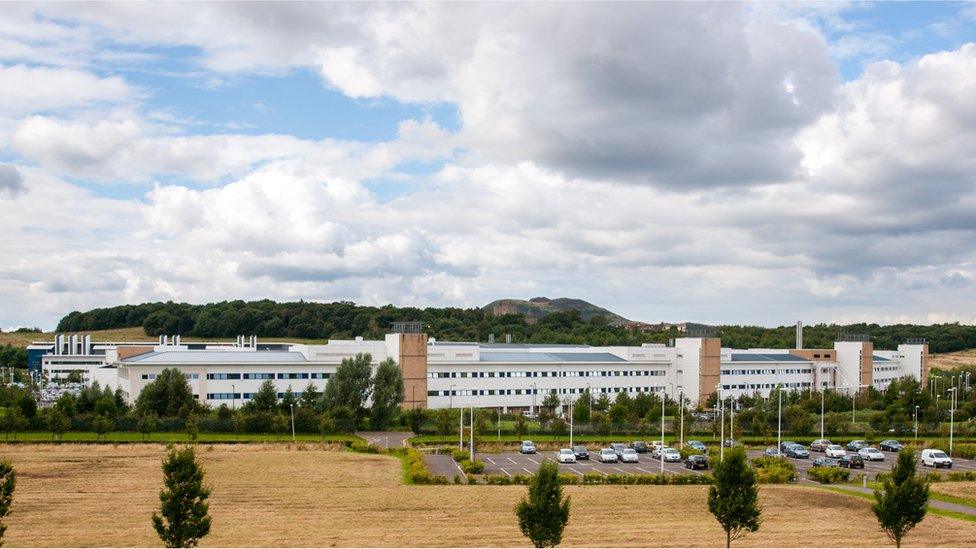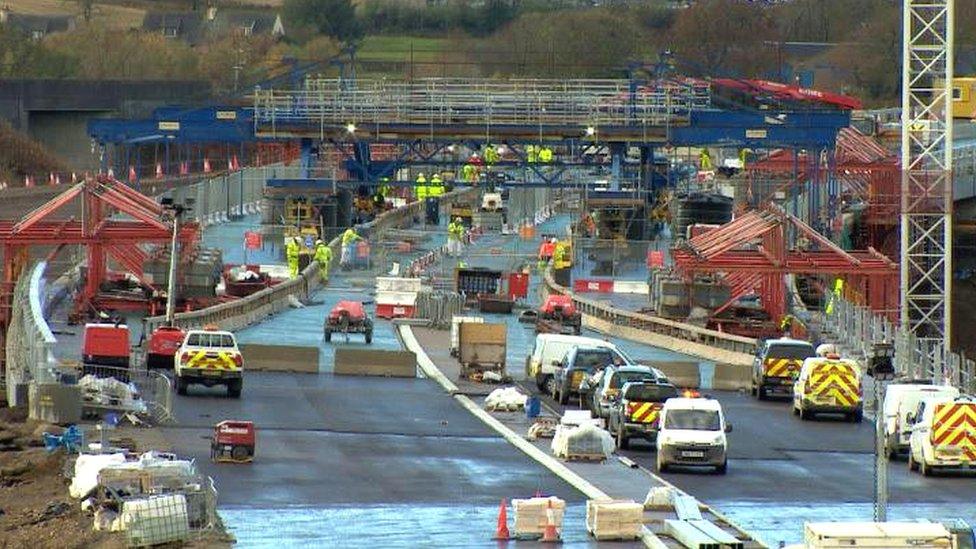Scottish Futures Trust: where to next?
- Published

The Scottish Futures Trust has been carving its own niche over 10 years of work across the public sector, to lever in private funds
It is now embarked on a new plan to make better use of the assets governments own
Energy efficiency and electric cars are in the plans
To make it happen, it's offering help to the construction industry to modernise the way it operates
If "kicking the can down the road" is the metaphor of the political year, maybe next year will see more attention paid to recycling cans and improving roads, because infrastructure is getting a bit more attention.
Margaret Thatcher ridiculed economists for using the term infrastructure, pointing out her prime ministerial limo made do with roads.
Twenty years ago, infrastructure was defined in media shorthand as schools, hospitals and bridges. Now, it's about tying the concrete, the bricks and the mortar to the wiring, cabling and connections between different public services which use them.
That's where the Scottish Futures Trust is today setting out its plans for a second decade - in the frontline of Scottish public services, yet often in the shade.
This is the outfit set up by SNP ministers when they took office, with a promise that it would reinvent private finance of public services with a nifty new system of bonds.
Different role
It didn't work out that way. Bonds weren't so simple, it turned out. So the SFT carved out a different role, as the broker and the expert in getting more bang for the government's infrastructure buck, across the Scottish public sector.
Its most recent impact assessment offers examples of services located in hubs - for instance, one in Anstruther which links the secondary school, leisure centre, library, college, police station and public access point for council services. There are now 40 such hubs across Scotland.
Councils have used its expertise to get the best deal out of private lenders. And so has Police Scotland.

The vast, ugly former headquarters of Strathclyde Police in Glasgow's Pitt Street has been sold, with the advice of the SFT, for conversion into 433 homes for rent - the biggest such build-to-rent project in Scotland, in a sector which is growing at scale.
On housing for ownership, it has innovated with an Ayrshire project which sells a new home to a first-time buyer for merely £5,000. That person gets to treat the place as her or his own, backed by the council for major repairs, for which an inflation-linked monthly fee is paid to grow the stake held. Older people can buy it with a starting stake of £40,000.
Place space
The overall Scottish government target is to save between £100m and £150m each year. SFT claims (it's bound to be hard to verify) to have done that each year of operation since 2009, most recently saving £139m.
So what's next? The prospect of £1.5bn more each year within six years. And a commission to look in depth at Scotland's infrastructure needs.

The SFT business and corporate plans reflect reforms in the way it is organised under Peter Reekie, who replaced Barry White as chief executive at the end of 2017.
Mr White - not in any way to be confused with the eponymous and lamented soul singer - has gone to improve transport corridors across the north of England, which frankly need all the help they can get.
The new set-up is to keep building out as the infrastructure budget expands, and advising others on how best to play their part, to manage projects and to raise private funds.
There's a division dedicated to "place"' - a buzzword of some significance as the public sector moves out of the housing mentality to talk of creating places where communities live, work, interact and access public services.
Private to Public
With quite a lot of assets now to its credit, it has a division to make sure they're run properly and efficiently, and that they're adaptable for changing service needs. In these hub developments, for instance, private companies no longer dictate when, and at what cost, parents can use their children's school in the evenings.
This is going to be important over the next decade, as those controversial Private Finance Initiative buildings come to the end of their private lives, and are handed over to the public sector.
One of the priorities Peter Reekie wants to set is to prepare for that transition, ensuring buildings are handed over in correct and contracted condition, and then kept that way under full public ownership.

Edinburgh Royal Infirmary will be one of the first buildings to reach the end of its private contract
The Edinburgh Royal Infirmary, for instance, should be one of the first. A highly controversial contract in the costs it put onto government, patients and the public.
This was designed before wifi, so it wasn't in the contract. My recent experience as a visitor is that it blocks outside signals, forcing patients who want to get internet access to pay high wifi rates to the building's owner.
That transition may bring some challenging conditions for bringing its private life to an end, and it will require a clever team of NHS Lothian facility managers to take it over smoothly.
The next few years will bring a higher profile to the smaller scale infrastructure. SFT is already working on the task of closing "not-spots" where 3G and 4G can't be found. It is now scoping out the challenges of bringing in 5G, with new masts and other infrastructure required.
It is also scoping the requirement to build and retrofit more energy-efficient buildings. And with the parallel move to both electric and autonomous vehicles, it is looking at the wiring, sensors and charging points that will be necessary to make that possible.
The 1,500 charging points for electric vehicles on which it is now engaged look like a very small part of what will be required for the shift to almost all electric by the end of next decade. Some experts think the shift could come much faster.
Construction 'inefficient'
And all this puts a lot of strain on the construction industry.
It has found working on public sector contracts has been financially very challenging of late. Interserve, the low margin, high volume firm which took on a humongous recycling and anaerobic digestion plant in south Glasgow is ruing the day it went into Energy from Waste.

Galliford Try has paid a heavy price for the cost over-runs on the Aberdeen Bypass project
It has since pulled out the sector, written off a £67m loss on Glasgow, and handed the unfinished building to Viridor.
Likewise, Galliford Try has sworn not to return to fixed-price contracts, after being severely burned on the Aberdeen ring road and still in dispute with other contractors over paying the cost over-run on the Queensferry Crossing.
This is not a sector - 6% of the Scottish economy, with 130,000 workers - in a happy or secure state to take on the additional £1.5bn of annual infrastructure investment by 2025. Lack of access, post-Brexit, to skilled workers from across Europe is just one of its problems.
Another is that construction has been inefficient and slow to adopt productivity improvements. SFT says one of the agency's new functions is not only to get the sector to work for the public realm, but to help the sector thrive and be healthy for the wider economy.
If they can partner on improved on-site modular building, learning from the best of manufacturing production runs, as well as using off-site factory build, there may not be so much need for those European workers, and more building per pound spent.